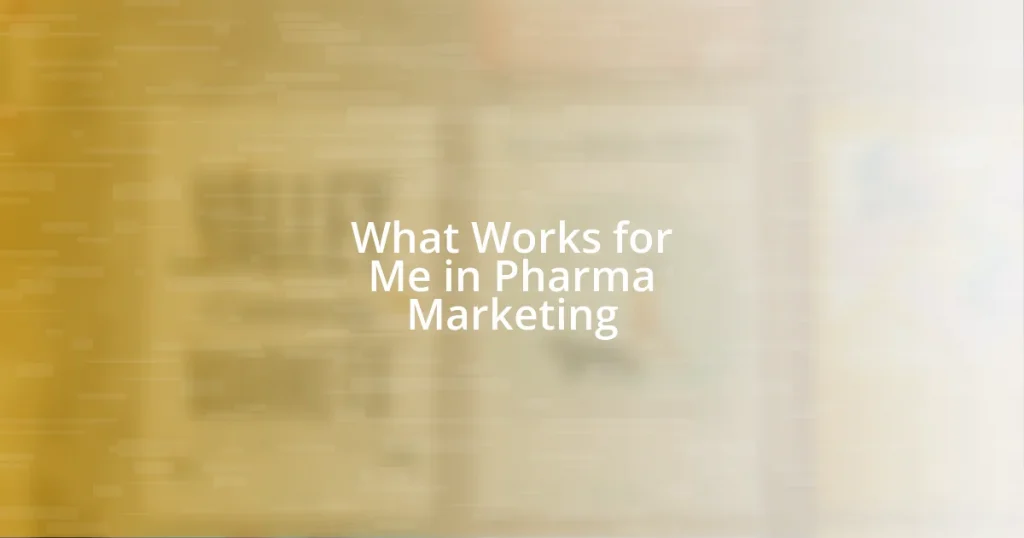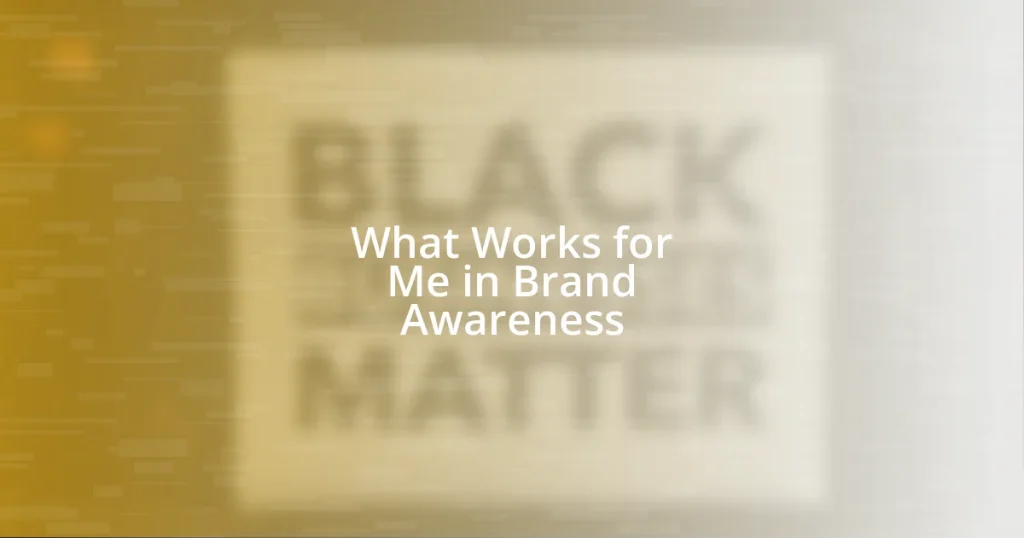Key takeaways:
- Understanding and adhering to advertising laws is essential for protecting consumers, maintaining trust, and promoting ethical marketing practices.
- Staying informed about legal updates through reliable resources and tools can transform compliance from a chore into an opportunity for business growth.
- Regular training, mentorship, and clear communication within teams foster a culture of compliance, enhancing both legal adherence and team morale.

Understanding advertising laws
Understanding advertising laws can feel overwhelming, especially when so much is at stake. I remember the first time I navigated these regulations; it was a bit like trying to decipher a foreign language. Why are these laws important? They exist to protect consumers from misleading or false information, ensuring that the claims we make are backed by truth.
As I delved deeper into the legal landscape, I realized that different platforms have different rules. For instance, social media advertising is governed by guidelines specific to that space. Keeping track of these nuanced regulations made me question: How can we effectively communicate our brand message while staying compliant? The answer lies in staying informed and adaptable, adjusting my strategies to align with the latest updates in advertising law.
In my experience, connecting with legal professionals has been invaluable. They’ve provided insights that not only clarify the rules but also shine a light on the ethical dimensions of advertising. It’s a reminder that, while compliance is critical, integrity in advertising builds trust with my audience, which is something I deeply value.

Importance of compliance
Staying compliant with advertising laws is crucial not only to avoid hefty penalties but also to maintain consumer trust. I’ve experienced firsthand how one misstep can lead to a public relations nightmare. Once, I mistakenly overlooked a specific regulation and faced backlash that could have been easily avoided by paying more attention to the compliance checklist. In the world of advertising, a single mistake can haunt you long after the ad has run.
Understanding the importance of compliance also strengthens my marketing strategies. When I prioritize transparency, it reflects positively on my brand. I recall a campaign where I clearly disclosed sponsorships and partnerships, which surprisingly enhanced my audience’s engagement. The openness fostered a sense of community and loyalty, making compliance not just a legal obligation, but a powerful tool for brand building.
Moreover, compliant advertising practices pave the way for more sustainable marketing efforts. My experience tells me that when audiences trust the information presented, they are more likely to make purchasing decisions based on authenticity. A well-informed consumer is a satisfied consumer, and creating a genuine relationship helps my business thrive in a competitive marketplace.
| Key Benefits of Compliance | Consequences of Non-Compliance |
|---|---|
| Builds consumer trust | Legal penalties |
| Enhances brand reputation | Loss of customer loyalty |
| Promotes ethical marketing | Negative publicity |

Keeping up with changes
Keeping up with advertising laws can feel like a constant game of catch-up. I often find myself browsing legal updates and guidelines, especially since these regulations can change overnight. Sometimes, I even set reminders to revisit key resources, ensuring I’m not left in the dark about any new developments that could impact my advertising strategies.
Here are some practical tips I employ to stay updated:
- Subscribe to industry newsletters from bodies like the FTC or advertising associations.
- Follow relevant legal experts on social media for real-time updates and insights.
- Join forums and discussion groups where compliance topics are frequently discussed.
- Attend webinars or workshops focused on advertising law changes.
It’s amazing how staying proactive can save a lot of headaches later on. Just last month, I stumbled upon a new guideline regarding influencer partnerships that could have significantly affected my current campaign. Luckily, I was quick to adapt my strategy, ensuring I remained compliant and forward-thinking. Keeping an eye on these changes really turns compliance from a chore into an opportunity for growth.

Best practices for advertising
In my journey through the world of advertising, I’ve discovered that blending creativity with compliance often yields the best results. For example, during a recent campaign, I made it a point to clearly label customer testimonials. This simple step not only adhered to advertising guidelines but also added credibility to the campaign, showing customers that I value transparency as much as I do engaging visuals.
One practice that has consistently helped me is creating a compliance checklist before launching any advertisement. I think about it like a pre-flight checklist; each item ensures that not only am I following the law, but I’m also presenting my brand in the best possible light. This habit came into play when I was about to release a series of ads that included product claims. A quick review made me realize I needed to substantiate those claims with evidence, which ultimately enhanced the ad’s effectiveness. Hasn’t everyone felt that rush of relief after dodging a potential mistake?
Another vital best practice is collaborating with legal professionals or compliance experts. By involving them in the creative process, I’ve often found new ways to spin ideas while still adhering to regulations. I remember the time when I brought a legal consultant into a brainstorming session; their insights opened my eyes to different angles and safer approaches for a particularly tricky campaign. It turns what might feel like a hurdle into an opportunity for innovative advertising, encouraging a partnership that fuels creativity while prioritizing compliance.

Tools for monitoring compliance
When it comes to monitoring compliance, I find technology can be a gamechanger. Tools like compliance management software allow me to keep tabs on the rules and regulations in real-time. A few months back, I started using a particular platform that automatically notifies me about changes in advertising legislation, making my life so much easier. Isn’t it reassuring to have a tool that does the heavy lifting for you?
Another invaluable resource has been social media monitoring tools. They help me track brand mentions and audience sentiment, ensuring that my messaging aligns with compliance standards. For example, after launching a campaign, I noticed some comments questioning product claims. Diving into those conversations not only proved essential for compliance but also provided invaluable feedback that helped refine future messages. Wouldn’t you agree that understanding consumer perception is as crucial as following the law?
Lastly, I can’t stress enough the importance of audits—both internal and external. Regularly scheduled compliance audits keep my advertising practices in check and highlight areas needing improvement. I vividly remember when an external audit revealed an oversight in an ad campaign I ran several months prior. It felt a bit daunting, but the findings ultimately led to positive changes and a stronger adherence to the regulations. Isn’t it fascinating how a little oversight can lead to vast improvements?

Training your team
Training your team is a fundamental step in fostering a culture of compliance within the advertising landscape. I make it a point to hold regular training sessions where I share updated advertising laws and regulations. I remember the time I led a workshop after a significant update in digital marketing rules; the spark in my team’s eyes when they grasped the implications was truly rewarding. It’s moments like these that remind me how empowering knowledge can be.
Beyond the basics, I focus on emphasizing real-world scenarios during our training. By discussing past campaigns—both successful and less so—I encourage my team to dissect what went right and what went wrong. I often ask, “What could we have done differently to stay compliant?” This reflective practice not only boosts their critical thinking but also instills a sense of ownership in their advertising efforts. I’ve watched them grow from mere participants to active contributors in compliance discussions, which is incredibly fulfilling.
Another strategy I’ve found effective is creating a mentorship program within the team. Pairing experienced members with newer ones fosters a collaborative environment where compliance knowledge is not only taught but also shared organically. One time, I paired a seasoned marketer with a newbie, and the insights exchanged in just a few sessions transformed the latter’s understanding of our compliance standards. It’s a beautiful thing to see that kind of growth—how can we not invest in our team’s future?

Consequences of non-compliance
Non-compliance can lead to severe consequences that can impact both your brand and your bottom line. I once encountered a situation where an oversight in our advertising led to a hefty fine. That experience was a wake-up call; it made me realize how easily one misstep can spiral into a crisis that costs money and damages reputation. Have you ever thought about the long-term effects of such penalties?
The fallout from failing to adhere to advertising laws can also be devastating in terms of consumer trust. I recall a campaign where we inadvertently made exaggerated claims. The backlash was immediate, with customers feeling misled. It was disheartening, but the lesson was invaluable: trust, once broken, takes significant time and effort to rebuild. Do you see how maintaining compliance is as crucial as the products we promote?
Lastly, there’s the impact on team morale and productivity. I remember when a compliance issue emerged that required us to backtrack on a significant campaign. The tension in the office was palpable; it felt like an unnecessary hurdle that detracted from our creative energy. I often think, how can we thrive if we aren’t vigilant about the rules that guide our work? Embracing compliance fosters not just legal security, but also a healthier work environment.















